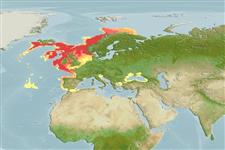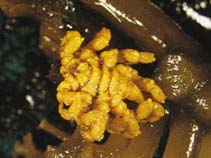Pycnogonum litorale (Strom, 1762)
Anemone sea spider| Native range | All suitable habitat | Point map | Year 2050 |

|
| This map was computer-generated and has not yet been reviewed. |
| Pycnogonum litorale AquaMaps Data sources: GBIF OBIS |
Classification / Names Common names | Synonyms | CoL | ITIS | WoRMS
Pycnogonida | Pantopoda | Pycnogonidae
Environment: milieu / climate zone / depth range / distribution range Ecology
Benthic; depth range 0 - 1262 m (Ref. 2007). Subtropical; 78°N - 30°N, 72°W - 37°E
Distribution Countries | FAO areas | Ecosystems | Occurrences | Introductions
Northern Atlantic, Arctic Ocean and the Mediterranean.
Length at first maturity / Size / Weight / Age
Maturity: Lm ? range ? - ? cm
Short description Morphology
Proboscis: Attached relatively large animals such as actinians or sponges. Cuticle (covering the proboscis): May be smooth, partly, or wholly covered with tubercles. Proboscis (tip): Small and buld-like, once inserted in the host tissues they close round it and help to anchor the mouth in position to maintain suction. Mouth at the tip of the proboscis: triadiate structure which usually has three lip-lobes with a number of small tubercles (Ref. 12). Feeding on hosts: hydroid Tealia crassicornis, by suction and rasping of jaws,Lucernaria, Cucumaria frondosa, Metridiumdianthus and Metridium senile (Ref. 233, 229); polyzoans rotting edges of Flustra foliaces (Ref. 234); Milne-Edwardsia loweni, Tealia crassicornis, Lucernaria, Cucumaria frondosa, Metridium dianthus, Metridium senile, and Cynthia. Method of feeding: insertion of proboscis into tissues of the host (Ref. 233, 229). Association with other animals: Clava multicornis, Actinia, Tealia, Metridium,and Alcyonarium digitatum (Ref. 213); polyzoan Flustra foliacea (Ref. 12). Development site of larval associations: Clava multicornis with proboscis inserted (Ref. 213). Reproduction system: ova ripen in the trunk part of the ovary. Life cycle: male rests for a long period on the back of the female with their genital orifices touching. These orifices are situated on the ventral surface of the second coxa of the last pair of legs in the male and on the dorsal aspect of the same leg and segment in the female. When eggs are released they forma single extensive ball in this species with both ovigerous legs embedded in it (Ref. 12).
Life cycle and mating behavior Maturity | Reproduction | Spawning | Eggs | Fecundity | Larvae
Reproduction system: ova ripen in the trunk part of the ovary. Life cycle: male rests for a long period on the back of the female with their genital orifices touching. These orifices are situated on the ventral surface of the second coxa of the last pair of legs in the male and on the dorsal aspect of the same leg and segment in the female. When eggs are released they form a single extensive ball in this species with both ovigerous legs embedded in it (Ref. 12).
Main reference
References | Coordinator | Collaborators
Bamber, R.N. and M.H. Thurston. 1995. (Ref. 1797)
IUCN Red List Status (Ref. 130435: Version 2024-1)
CITES status (Ref. 108899)
Not Evaluated
CMS (Ref. 116361)
Not Evaluated
Threat to humans
Human uses
| FishSource |
Tools
More information
Trophic Ecology
Ecology
Population dynamics
Growth
Age/Size
Length-weight
Length-length
Length-frequencies
Mass conversion
Recruitment
Abundance
Age/Size
Length-weight
Length-length
Length-frequencies
Mass conversion
Recruitment
Abundance
Life cycle
Distribution
Human Related
Aquaculture profile
Stamps, Coins Misc.
Stamps, Coins Misc.
Outreach
References
Internet sources
BHL | BOLD Systems | CISTI | DiscoverLife | FAO(Publication : search) | Fishipedia | GenBank (genome, nucleotide) | GloBI | Gomexsi | Google Books | Google Scholar | Google | PubMed | Tree of Life | Wikipedia (Go, Search) | Zoological Record
Estimates based on models
Preferred temperature
(Ref. 115969): 4.1 - 11.3, mean 8 (based on 132 cells).
Price category
(Ref. 80766):
Unknown.



